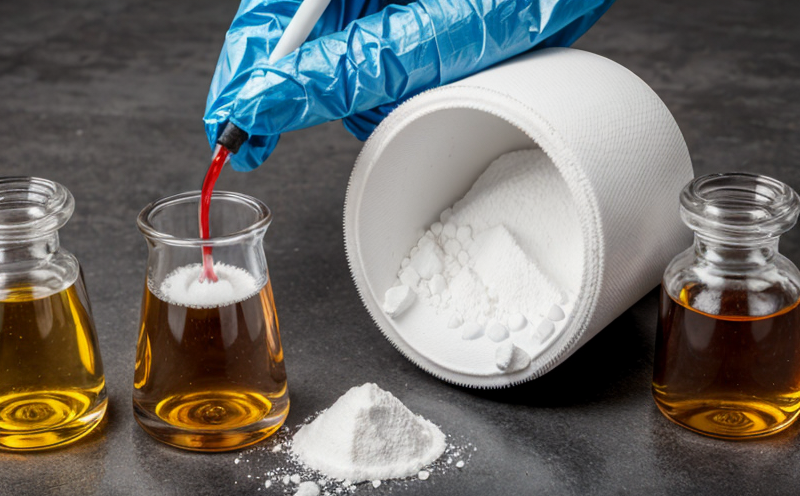DIN 38414 Testing of Sludge and Sediment Chemical Compliance
The DIN 38414 series is a comprehensive set of standards developed by the German Institute for Standardization (DIN) to ensure the chemical, biological, and physical quality of sludge and sediment. This service focuses on the specific testing parameters outlined in DIN 38414: Part 260, which pertains to the determination of heavy metals and other potentially hazardous substances in sludge and sediment.
Sludge and sediment are often by-products from industrial processes or wastewater treatment facilities. Proper chemical compliance ensures that these materials do not pose a risk to human health or the environment when disposed of or reused. This service is crucial for industries such as water treatment, mining, and manufacturing, where sludge and sediment management is essential.
Our laboratory adheres strictly to DIN 38414: Part 260, which specifies methods for the extraction of metals from sludge and sediment samples using acid digestion. The method involves dissolving the solid matrix with nitric acid and perchloric acid in a microwave digestion system. Once the sample is digested, the solution undergoes several steps to ensure accurate quantification of heavy metals.
The testing process begins with the receipt of sludge or sediment samples. These are typically collected from wastewater treatment plants, industrial facilities, or mining operations. After receipt, the samples are weighed and prepared for digestion according to DIN 38414: Part 260 guidelines. The extraction solution is then analyzed using inductively coupled plasma mass spectrometry (ICP-MS) to determine the concentration of heavy metals.
The accuracy and precision of these tests are critical, as even trace amounts of certain heavy metals can be harmful if not properly managed. Our laboratory employs highly skilled technicians who follow strict protocols to ensure that all samples are prepared and analyzed consistently. This consistency is essential for providing reliable results that meet international standards such as DIN 38414: Part 260.
The testing process typically takes several days, depending on the complexity of the sample and the number of metals being tested. Once complete, our laboratory issues a comprehensive report detailing the concentrations of heavy metals detected in the sludge or sediment sample. This report is invaluable for environmental risk assessment and compliance with regulatory requirements.
DIN 38414: Part 260 also includes stringent quality control measures to ensure that all tests are conducted accurately and consistently. These measures include regular calibration of equipment, participation in proficiency testing programs, and ongoing training for laboratory personnel. This dedication to quality is reflected in the reliability and accuracy of our test results.
Understanding the chemical composition of sludge and sediment is vital for industries involved in environmental management, waste disposal, and recycling. By adhering strictly to DIN 38414: Part 260, we provide a robust framework for ensuring that these materials are handled safely and responsibly.
Why It Matters
The importance of chemical compliance testing in sludge and sediment cannot be overstated. Proper management of these by-products is essential for environmental protection and public health. Heavy metals such as lead, cadmium, mercury, and arsenic can accumulate in the environment over time if not managed correctly.
- Lead: A neurotoxin that can cause damage to the brain and kidneys.
- Cadmium: Linked to kidney disease and bone disorders.
- Mercury: Known for its toxicity to the nervous system, especially in children.
- Arsenic: Carcinogenic and toxic to various organs.
The presence of these heavy metals can lead to water pollution, soil contamination, and harm to wildlife. By ensuring that sludge and sediment meet chemical compliance standards, industries contribute significantly to environmental conservation efforts.
In addition to protecting the environment, adherence to DIN 38414: Part 260 helps companies comply with legal requirements and avoid costly penalties. Many countries have strict regulations governing the disposal of industrial waste, including sludge and sediment. By conducting thorough testing and ensuring compliance, businesses can safeguard their reputation and avoid potential legal issues.
Eurolab Advantages
At Eurolab, we pride ourselves on providing top-tier laboratory services that go above and beyond industry standards. Our DIN 38414: Part 260 testing service is no exception. Here are some of the advantages our clients enjoy:
- Expertise in Chemical Compliance: Our team comprises highly skilled chemists with extensive experience in environmental testing.
- Advanced Equipment: We utilize state-of-the-art ICP-MS equipment to ensure precise and accurate results.
- Comprehensive Reporting: Clients receive detailed reports that include all test data, interpretations, and recommendations for disposal or reuse.
- ISO 17025 Accreditation: Our laboratory is accredited under ISO 17025:2017, ensuring the highest level of quality assurance.
We understand that every client has unique needs, and we tailor our services to meet those requirements. Whether you need routine testing or one-off assessments, Eurolab is committed to delivering exceptional service.
Use Cases and Application Examples
DIN 38414: Part 260 is widely used across various industries. Here are some examples of how this service can be applied:
| Industry | Application Example |
|---|---|
| Water Treatment | Testing sludge from wastewater treatment plants to ensure safe disposal. |
| Mining | Evaluating sediment samples for heavy metal content before reclamation projects. |
| Manufacturing | Determining the chemical composition of sludge from industrial processes to ensure compliance with environmental laws. |
- In water treatment, testing sludge can help determine if it is safe for land application or if additional treatment is necessary.
- In mining operations, sediment analysis helps in planning reclamation projects and assessing the risk of heavy metal contamination.
- For manufacturing plants, knowing the chemical composition of sludge ensures compliance with environmental regulations and proper waste disposal practices.
By providing detailed insights into the chemical makeup of sludge and sediment, DIN 38414: Part 260 testing supports informed decision-making in various industries.





